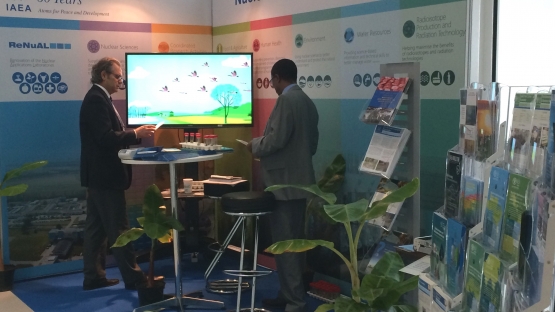During the IAEA’s ongoing 61st General Conference, the Department of Nuclear Sciences and Applications (NA) is hosting several side events and two “ESPACE” presentations. On Monday, the successful launch of the donor wall for ReNuAL (Renovation of the Nuclear Applications Laboratories in Seibersdorf) took place. Two new donations for ReNuAL were announced: the United States pledged an additional $3.1 million, while Germany pledged an additional €1 million.
NA also hosted a joint session on Radiation Risk Assessment and Risk Perception in Medical Imaging, along with the Department of Nuclear Safety and Security (NS), the World Health Organization (WHO), and the United Nations Scientific Committee on the Effects of Atomic Radiation (UNSCEAR).
NA has three additional side events, all happening on Thursday, 21 September. Every event will be open to all registered participants of the General Conference. Below is a brief summary of each event, as well as time and location information so you can find your way. Underneath the side event descriptions, please find the schedule for our two ESPACE presentations.
Monitoring Contaminants for Safer Seafood
Thursday, 21 September; 10:00-11:30am; Conference Room M7, M building, ground floor
Pollutants and contaminants that make it into the ocean can also make it into seafood. This event will provide an overview of techniques to monitor biotoxins in harmful algal blooms, contaminants like mercury, polychlorinated biphenyls, and plastics in our oceans and in seafood.
Neuropsychiatry: The Revolution of Molecular Imaging in Alzheimer’s disease
Thursday, 21 September; 12:30-2:00pm; Conference Room M7, M building, ground floor
This event will look at the rapid progress of functional and structural brain imaging, and the vital role the latter plays in the differential diagnosis of dementia, early recognition of progressive dementia, and monitoring of disease progression and treatment effects.
Molybdenum-99/Technetium-99m: Current Supply Scenario, New Alternatives for their Production and the Role of the IAEA
Thursday, 21 September; 3:00-5:00pm; Conference Room M7, M building, ground floor
Molybdenum-99 is a radioactive isotope that gets produced in reactors, so it can decay into technetium-99m, which is a vital isotope in nuclear medicine diagnostic procedures. This event will outline the current supply scenario of molybdenum-99 and technetium-99m, and the role of the IAEA in supporting Member States to improve national production capacity.


